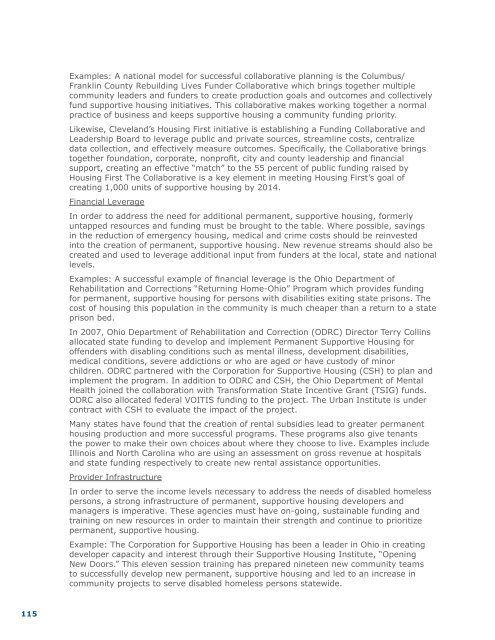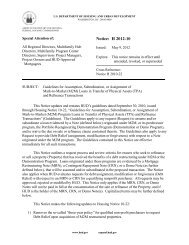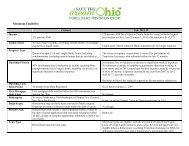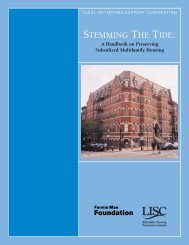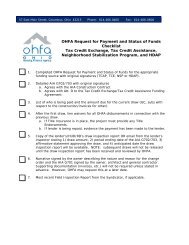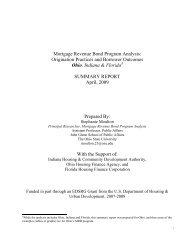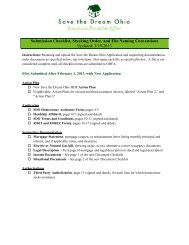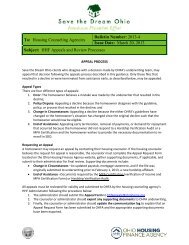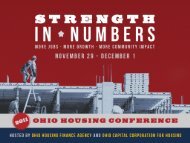“Financing PSH is complicated. <strong>Housing</strong> and service providers must layer funds frommany sources…Operating and services funding typically is the hardest money to secure.It must be available on an annual basis and many funders have restrictions on howthe money can be used, including who can be served, the types of projects that can bedeveloped and the types of activities that can be funded. Urban, suburban and ruralcommunities all face this challenge.<strong>Plan</strong>s to end homelessness are gaining momentum at the federal, state and locallevel. There is a pipeline of PSH projects in communities around <strong>Ohio</strong> that will meetthe needs of more than 1,000 long-term homeless individuals and families over thenext three years. Rural and urban communities across <strong>Ohio</strong> have worked with localhousing authorities, mental health boards and Continuums of Care to secure funding forsupportive housing operations and services. Despite this progress, there is a significantshortfall of operating and services subsidy that will limit the continued development ofPSH and keep homeless people in shelters and places not meant for human habitation fortoo long.“ 9Waiting lists demonstrate additional gaps in funding. For example,” housing data for (mentalhealth) consumers showed increased demand and less access. For supported housing thenumber of consumers waiting increased from 2,372 to 3,387 and the number waiting morethan a year increased from 17 percent to 21 percent between 2004 and 2008.” 10Best Practices Policies and Programs Relevant to PSHCSH Building BlocksThe Corporation for Supportive <strong>Housing</strong> (CSH) has been working to provide advocacy,leadership and financial resources for the creation of permanent, supportive housing forseventeen years. Their expertise and research of supportive housing have led them tothe identification of six building blocks 11 that have been present in successful permanent,supportive housing nationwide. The six key indicators that should be present to develop anadequate supply of successful permanent, supportive housing are:LeadershipHighly placed or influential policy leaders must be educated and motivated to advance thecause of permanent supportive housing in local and state government and with the mediaand public at large. These influential policy leaders may include elected officials, seniorstaff at key agencies, philanthropic and business leaders or leaders in the non-profit andadvocacy sectors. Their influence will usually lead to a better understanding of the needand value of permanent, supportive housing and lead to coordinated efforts of local andstate leadership in addressing the problem.Example: In <strong>Ohio</strong>, the Homeless Solutions Board of Dayton/Montgomery County wasdeveloped as a result of the leadership of the County Administrator, the City Manager andlocal elected officials investing in a committed ten year plan to end homelessness. Theplan has begun implementation for 750 units of PSH.Collaborative <strong>Plan</strong>ningPermanent, supportive housing production and management is most successful whenplanning bodies are formed on a local and/or statewide basis to design and moveproduction goals and shift between big visions and fine details.9Permanent Supportive <strong>Housing</strong> Gap Program, as presented to the Governor’s Interagency Council on Homelessness and Affordable<strong>Housing</strong>, September 25, 2008.10<strong>Ohio</strong> Department of Mental Health, 2009 Community <strong>Plan</strong> Report System Performance Indicators11Corporation for Supportive <strong>Housing</strong>, Toolkit for Advancing Systems Change, Available Internet: http://intranet.csh.org/index.cfm?fuseaction=Page.viewPage&pageId=4028&stopRedirect=1114
Examples: A national model for successful collaborative planning is the Columbus/Franklin County Rebuilding Lives Funder Collaborative which brings together multiplecommunity leaders and funders to create production goals and outcomes and collectivelyfund supportive housing initiatives. This collaborative makes working together a normalpractice of business and keeps supportive housing a community funding priority.Likewise, Cleveland’s <strong>Housing</strong> First initiative is establishing a Funding Collaborative andLeadership Board to leverage public and private sources, streamline costs, centralizedata collection, and effectively measure outcomes. Specifically, the Collaborative bringstogether foundation, corporate, nonprofit, city and county leadership and financialsupport, creating an effective “match” to the 55 percent of public funding raised by<strong>Housing</strong> First The Collaborative is a key element in meeting <strong>Housing</strong> First’s goal ofcreating 1,000 units of supportive housing by 2014.Financial LeverageIn order to address the need for additional permanent, supportive housing, formerlyuntapped resources and funding must be brought to the table. Where possible, savingsin the reduction of emergency housing, medical and crime costs should be reinvestedinto the creation of permanent, supportive housing. New revenue streams should also becreated and used to leverage additional input from funders at the local, state and nationallevels.Examples: A successful example of financial leverage is the <strong>Ohio</strong> Department ofRehabilitation and Corrections “Returning Home-<strong>Ohio</strong>” Program which provides fundingfor permanent, supportive housing for persons with disabilities exiting state prisons. Thecost of housing this population in the community is much cheaper than a return to a stateprison bed.In 2007, <strong>Ohio</strong> Department of Rehabilitation and Correction (ODRC) Director Terry Collinsallocated state funding to develop and implement Permanent Supportive <strong>Housing</strong> foroffenders with disabling conditions such as mental illness, development disabilities,medical conditions, severe addictions or who are aged or have custody of minorchildren. ODRC partnered with the Corporation for Supportive <strong>Housing</strong> (CSH) to plan andimplement the program. In addition to ODRC and CSH, the <strong>Ohio</strong> Department of MentalHealth joined the collaboration with Transformation State Incentive Grant (TSIG) funds.ODRC also allocated federal VOITIS funding to the project. The Urban Institute is undercontract with CSH to evaluate the impact of the project.Many states have found that the creation of rental subsidies lead to greater permanenthousing production and more successful programs. These programs also give tenantsthe power to make their own choices about where they choose to live. Examples includeIllinois and North Carolina who are using an assessment on gross revenue at hospitalsand state funding respectively to create new rental assistance opportunities.Provider InfrastructureIn order to serve the income levels necessary to address the needs of disabled homelesspersons, a strong infrastructure of permanent, supportive housing developers andmanagers is imperative. These agencies must have on-going, sustainable funding andtraining on new resources in order to maintain their strength and continue to prioritizepermanent, supportive housing.Example: The Corporation for Supportive <strong>Housing</strong> has been a leader in <strong>Ohio</strong> in creatingdeveloper capacity and interest through their Supportive <strong>Housing</strong> Institute, “OpeningNew Doors.” This eleven session training has prepared nineteen new community teamsto successfully develop new permanent, supportive housing and led to an increase incommunity projects to serve disabled homeless persons statewide.115
- Page 3 and 4:
OHFA Annual PlanThe Ohio Housing Fi
- Page 5:
Mission StatementsThe OHFA Annual P
- Page 8 and 9:
The State’s Housing NeedsAffordab
- Page 10 and 11:
Subject Matter Expert (SME) Workgro
- Page 12 and 13:
3. Financial LiteracyOHFA and other
- Page 14 and 15:
Affordable Housing Preservation & D
- Page 16 and 17:
federal subsidies. To achieve this
- Page 18 and 19:
Accessible HousingBackground DataOh
- Page 20 and 21:
3) Create dedicated funding streams
- Page 22 and 23:
• Recommend that Ohio support the
- Page 24 and 25:
Rural and Appalachian RegionsBackgr
- Page 26 and 27:
6. Annual Set-Asides and Incentives
- Page 28 and 29:
• Several cities in Ohio current
- Page 30 and 31:
OHFA should provide funding, traini
- Page 32 and 33:
Permanent Supportive Housing Produc
- Page 34 and 35:
3. The State should assist local Co
- Page 45 and 46:
PrioritizationThe challenge of prio
- Page 47 and 48:
Agency RecommendationsThe Annual Pl
- Page 49 and 50:
APPENDIXWorkgroup 1: Affordable Hom
- Page 51 and 52:
Executive SummaryHousing Need Descr
- Page 53 and 54:
efficiency and resource conservatio
- Page 55 and 56:
554. Home Buyer Education in OHFA F
- Page 57 and 58:
Estimated Units in Need of Some For
- Page 59 and 60:
Ohio County Foreclosure Filings (19
- Page 61 and 62:
Operating Costs - Met and Unmet Nee
- Page 63 and 64: Workgroup #2:Affordable Housing Pre
- Page 65 and 66: Secondary Recommendations• Explor
- Page 67 and 68: Executive SummaryOhio’s supply of
- Page 69 and 70: Met Housing Needs (“Resource Inve
- Page 71 and 72: Ohio Deptof MentalRetardation andDe
- Page 73 and 74: Unmet Housing NeedsData OverviewThe
- Page 75 and 76: ody, and will be built within the C
- Page 77 and 78: • OHFA will continue to maintain
- Page 79 and 80: Best Practices, Policies and Progra
- Page 81 and 82: addition, 60,111 one-person househo
- Page 83 and 84: Across Ohio, people with very low i
- Page 85 and 86: • Responsible for Rent - The pers
- Page 87 and 88: Seattle, St. Louis, and Washington,
- Page 89 and 90: Primary Recommendations• Create a
- Page 91 and 92: Unmet Housing Needs:• Due to the
- Page 93 and 94: • The cost of construction often
- Page 95 and 96: Recommendations for Annual Plan Adv
- Page 97 and 98: capacity to quantify vacant propert
- Page 99 and 100: distributed on or about January 15,
- Page 101 and 102: Action is needed at the State level
- Page 103 and 104: a “user-friendly” data system,
- Page 105 and 106: 5) Incentivize the formation of bro
- Page 107 and 108: Workgroup #8:Permanent Supportive H
- Page 109 and 110: 3. Assist local Continuums of Care
- Page 111 and 112: Program and Resource InventoryNonpr
- Page 113: Table 2PopulationsPersons whoexperi
- Page 117 and 118: oles, so they create a contract bet
- Page 119 and 120: Workgroup #8:Appendix ANameProgramD
- Page 121 and 122: or remedyingneglect, abuse,or the e
- Page 123 and 124: ased healthcare, and earlyintervent
- Page 125 and 126: “Bob” of Stark County, OhioPubl


